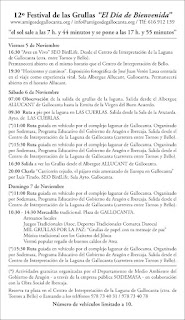Jijona Casta Recovery in the VII Conference on bullfighting cattle at the Public University of Navarra. .

program attach the VII Conference on Livestock Lidia to be held at the Public University of Navarra next November.
.
thank the organizations that participate the program. Especially we thank you from starting the conference with a presentation on the Recovery of Jijona Casta. What can we say on this site about this?. Applies only in capital letters. THANKS !.
.
is of utmost importance that precisely in the year of biodiversity and a School of Agricultural Engineers we talk about the conservation of a breed of cattle to many until very recently were given by extinguished.
.
We must also congratulate the organizers for the speaker chosen for the advocacy of the caste Jijona: Juan Carlos Gil is someone who has not hidden his interest in our goals Preservation of the "Toro Jijón" not in vain was concerned to know the concluisiones and inquiries had been made by the hand of Lorenzo Ceron Miranda on the evolution of caste and the reasons Jijona demonstration of its actual existence in our bravo cabin. We are delighted the article elaborated on one of the Livestock that far from concealing its origin jijona the proclamation in his name "Casta Peñajara Jijona" in which they take into account the findings made. In the articles section you can find the details of this publication.
Juan Carlos Gil should be taken into account in all forums as an ambassador for this cause protectionist existing biodiversity in the different herds of bulls, especially the caste Jijona.
FRIDAY, November 19, 2010
Download pdf program
09.00 - 09.30 Cast
documentation from 09.30 to 10.00 Opening and presentation Days
-Vice Chancellor of Student UPNA, Javier Casali
-Director the School of Agricultural Engineers, Ana Arana
-Chairs of the Conference, Antonio Purroy, Carlos Buxadé
Foundations Recovery
Breeds from 10.00 to 10.30 Identification and recovery of the Casta Navarra
Miguel Reta
10 , 30 to 11.00 Recovery Jijona Casta
Juan Carlos Gil
11.00 to 11.30 Discussion (Moderator: Ignacio J. Martinez Alfaro)
11.30-12.00 Coffee - Break
The economy of the Fiesta
12.00-12.30 How does the crisis affect the Fiesta
Carlos Buxadé
12.30 to 13.00 The economic impact of the Fiesta
Julian Montanes
13.00 - 13.30 Discussion (Moderator: Jose Antonio Mendizabal)
13.30 to 16.00 Break - Food
Importance of Party
16.00-17.00 Round Table: Between death and glory
-Max G ª Padrós (Surgeon-Chief, Sales)
-Angel Hidalgo (Surgeon-in-chief, Pamplona) Ivan
-Fandino (Matador de Toros)
17.00 to 17.30 Discussion (Moderator: Carlos Buxadé)
17.30-18.00 Coffee - Break
18.00 to 18.30 The modern bullfighting as a threat of Lidia encastes
bull Rafael Cabrera
18.30 to 19.00 The chair of bullfighting
Matias Gonzalez, Inaki Arrazola
19.00 to 19.30 Discussion (Moderator: Javier Fernandez)
20.30 Reception at the Municipality of Pamplona
SATURDAY, November 20, 2010
Bravery
09.45 to 10.15 Changes the fate of poles and flags
Manuel Sales, Julio Fernandez
10.15 to 10.45 The secrets of bravery
José Rufino "Peñajara"
10.45 to 11.15 Discussion (Moderator: Patxi Arrizabalaga)
11 15 to 11.45 Coffee - Break
11.45 to 13.15 Roundtable: The bull seen from the field from the ring, from the street
-Borja Domecq "Jandilla (bulls Livestock)
-Eduardo Dávila Miura (Matador de Toros)
-Alberto de Jesus (Director of the magazine" Bous al Carrer ")
(Moderator: Antonio Purroy)
13.15-13.30 Summary of Days (Antonio Purroy)
13.30 Closing of the Conference
Mayor of Pamplona, \u200b\u200bYolanda Barcina
Parallel activities
Taurine Presentation of Agenda 2011 (editor: Vidal Pérez Herrero) and photo exhibition on "The bull in the field" ( http://www.porlasrutasdeltoro.com/ )
Speakers and moderators
Purroy -Antonio (Professor of Animal Production. ETSIA, Pamplona)
Buxadé
-Carlos (Professor of Animal Production . ETSIA, Madrid), Miguel Reta
(Technical and Livestock ITGG bulls, Pamplona)
-Juan Carlos Gil (Director of the Chair Sánchez Mejías, Universidad de Sevilla), Ignacio J.
Martínez Alfaro (Ex-Minister of Agriculture, Government of Navarra)
-Julio Montaner (industrial technical engineer and economist, Zaragoza)
-José Antonio Mendizabal (Prof. of Animal Production. ETSIA, Pamplona)
-Max G ª Padrós (Surgeon-in-chief of the Plaza de Las Ventas, Madrid)
-Angel Hidalgo (Surgeon-chief Pamplona bullring)
Ivan
-Fandino (Matador de toros, Orduña [Vizcaya])
-Rafael Cabrera (Head information taurine COPE)
-Matías González (President of the plaza de toros de Bilbao)
-Inaki Arrazola (Veterinary Advisory bullring in Bilbao)
-Javier Fernandez (Veterinary Advisor Las Ventas, Madrid)
-Julio Fernandez (Veterinario. Union of Breeders of Fighting Bulls, Madrid)
-Manuel Sales (former bullfighter)
-José Rufino (Livestock bulls "Peñajara", Badajoz), Patxi
Arrizabalaga ( Degree in Law and bullfighting critic, Pamplona)
-Borja Domecq "Jandilla (Livestock bulls (Mérida, Badajoz))
-Eduardo Dávila Miura (Matador de Toros, Sevilla)
-Alberto de Jesus (Director of the magazine "Bous al Carrer")
Sponsors
-Government
Navarra Public University of Navarra,
-City Hall Pamplona
-Bodega Otazu Manor Unzué
-Feed-Pfizer, SA
SETN
-Ford-Dodge - Veterinary Division
-Trouw Nutrition Spain
Organized by:
- School of Agricultural Engineers (ETSIA)
- Public University of Navarra
Directors of the Conference:
- Purroy Unanua Antonio Carlos Buxadé Carbó
-
Venue:
- Sala de Grados
- Department Building
- Olivet School of Agricultural Engineers (ETSIA)
- Public University of Navarra Pamplona
-
http://www.unavarra.es/jornadas_lidia/programa.htm
.







